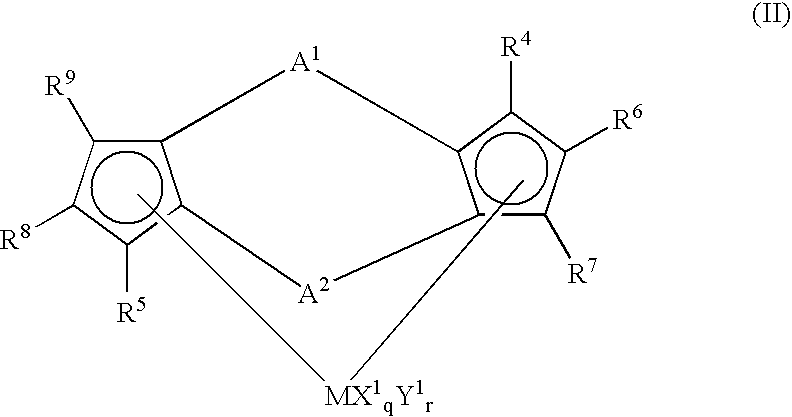Higher olefin polymer having polar group and process for producing the same
a technology of olefin polymer and polar group, which is applied in the field of higher olefin polymer having a polar group, to achieve the effects of high compatibility, high polarity, and high mixability and adhesion
- Summary
- Abstract
- Description
- Claims
- Application Information
AI Technical Summary
Benefits of technology
Problems solved by technology
Method used
Image
Examples
production example 1
Preparation of (1,2′-dimethylsilylene)(2,1′-dimethylsilylene)bis(3-trimethylsilylmethylindenyl)zirconium dichloride
[0207] 3.0 g (6.97 mmol) of lithium salt of (1,2′-dimethylsilylene) 2,1′-dimethylsilylene)-bis(indene) was dissolved in 50 ml of THF (tetrahydrofuran) in a Schrenk bottle and the resultant solution was cooled to −78° C.
[0208] To the solution was dropwise added 2.1 ml (14.2 mmol) of iodotrimethylsilane, followed by stirring at room temperature for 12 hrs.
[0209] The solvent was distilled off, 50 ml of ether was added and subsequently washed with saturated ammonium chloride solution.
[0210] After separation, the organic phase was dried and the solvent was distilled off to obtain 3.04g (5.88 mmol) of (1,2′-dimethyisilylene)(2,1′-dimethylsilylene)bis(3-triethylsilylmethylindene). (Yield, 84%)
[0211] Then, to the Schrenk bottle was added 3.04 g (5.88 mmol) of(1,2′-dimethylsilylene)(2,1′-dimethylsilylene)-bis(3-trimethylsilylmethylindene) obtained by the above methods and 5...
production example 2
Preparation of polyoctadecene
[0221] Into a 10 liter autoclave heated and dried was added 3 L of octadecene, 3 L of heptane, 5 mmol of triisobutylaluminum, 20 μmol of(1,2′-dimethylsilylene)(2,1′-dimethylsilylene)bis(3-trimethylsilylmethylindenyl)zirconium dichloride and 40 μmol of dimethylanilynium tetrakispentafluorophenylborate, followed by incorporating hydrogen of 0.1 MPa and subsequently polymerizing at a polymerization temperature of 60° C. for 420 min.
[0222] After the completion of the polymerization, the reaction product was precipitated with acetone, followed by heating and drying treatment under vacuum to obtain 1895 g of polyoctadecene which is a higher α-olefin polymer. The results of the properties of the obtained polymer evaluated by the above-mentioned methods are shown below. [0223] X1: 21.2°[0224] X1 strength ratio: 100% [0225] Mw (GPC): 95000 [0226] Mw / Mn: 1.7 [0227]ΔH: 80 J / g [0228] Tm: 42° C. [0229] Wm (DSC peak half-width temperature): 3.1° C.
production example 3
(Preparation of polyC20-24)
[0230] Into a 10 liter autoclave heated and dried was added 2.8 kg of “LINEALENE 2024” manufactured by IDEMITSU PETROCHEMICAL CO., 4 L of heptane, 5 mmol of triisobutylaluminum, 20 μmol of (1,2′-dimethylsilylene) 2,1′-dimethylsilylene)bis(3-trimethylsilylmethylindenyl)zirconium dichloride and 40 μmol of dimethylanilynium tetrakispentafuorophenylborate, followed by incorporating hydrogen of 0.1 MPa and subsequently polymerizing at a polymerization temperature of 60° C. for 480 min.
[0231] After the completion of the polymerization, the reaction product was precipitated with acetone, followed by heating and drying treatment under vacuum to obtain 1500 g of poly C20-24 which is a higher α-olefin polymer. The results of the properties of the obtained polymer evaluated by the above-mentioned methods are shown below. [0232] X1: 21.3°[0233] X1 strength ratio: 100% [0234] Mw (GPC): 48000 [0235] Mw / Mn: 1.6 [0236]ΔH: 82 J / g [0237] Tm: 49° C. [0238] Wm (DSC peak hal...
PUM
| Property | Measurement | Unit |
|---|---|---|
| 2θ | aaaaa | aaaaa |
| molecular weight distribution | aaaaa | aaaaa |
| molecular weight distribution | aaaaa | aaaaa |
Abstract
Description
Claims
Application Information
 Login to View More
Login to View More - R&D
- Intellectual Property
- Life Sciences
- Materials
- Tech Scout
- Unparalleled Data Quality
- Higher Quality Content
- 60% Fewer Hallucinations
Browse by: Latest US Patents, China's latest patents, Technical Efficacy Thesaurus, Application Domain, Technology Topic, Popular Technical Reports.
© 2025 PatSnap. All rights reserved.Legal|Privacy policy|Modern Slavery Act Transparency Statement|Sitemap|About US| Contact US: help@patsnap.com



